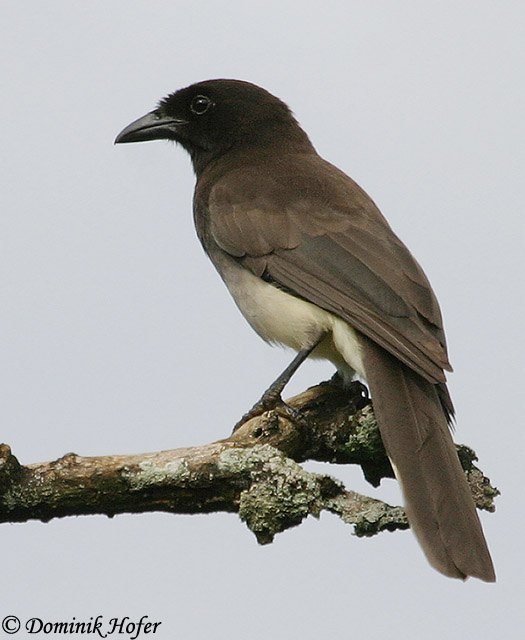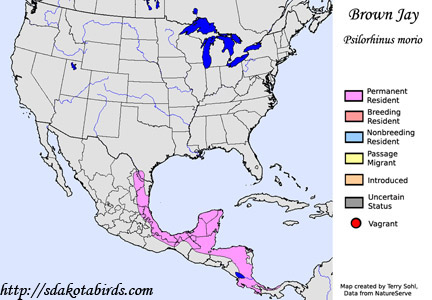| Length: 16 inches | Wingspan: 26 inches | Seasonality: Non-resident in South Dakota |
| ID Keys: Very large size, dark brown overall with white belly and undertail coverts | ||
 The
Brown Jay is a very large Jay species found mostly in Mexico and Central
America. In the United States, their range just extends into southern
Texas, where they are most often found in riparian forests along the Rio
Grande river. There are a few scattered historical records of the
species in South Texas, but they are considered more common residents in
recent decades than they were historically.
The
Brown Jay is a very large Jay species found mostly in Mexico and Central
America. In the United States, their range just extends into southern
Texas, where they are most often found in riparian forests along the Rio
Grande river. There are a few scattered historical records of the
species in South Texas, but they are considered more common residents in
recent decades than they were historically.
Habitat: Found in a variety of forested habitats, particularly open forested habitats, forest edges, and in forest clearings. Not often found in dense unbroken forest. They will utilize second-growth and other highly disturbed forest areas.
Diet: Omnivorous, feeding on both plant and animal matter. Food items may include insects and spiders, other invertebrates, small rodents, small lizards and snakes, eggs, and recently hatched small birds. They also will feed on fruits, berries, nuts, seeds, and nectar from flowers.
Behavior: Uses a variety of foraging techniques, depending upon location and available food items. They are typically gregarious when foraging, moving about in small flocks.
Nesting: Brown Jays have a unusual nesting system, using a cooperative nesting system. Small flocks form, and each flock only produces one nest. Multiple females in the group may lay eggs in the single nest, which is a large cup built of sticks and twigs, placed in a tree. The females lay between 2 and 6 eggs, and females alone incubate the eggs. When the eggs hatch, the young are fed by all adults in the group. The young leave the nest after about 3 or 4 weeks.
Song: The most common call of a Brown Jay is a strong clear bugling note, often given in series. Flocks of Brown Jays are typically conspicuous and very vocal, calling frequently to each other.
Migration: Considered a permanent resident throughout its normal range.
Interactive eBird Map: Click to access an interactive eBird map of Brown Jay sightings
Similar Species: Not likely to be confused with another species if seen well.
Conservation Status: Populations are large, appear to be stable or increasing, and are found over a relatively wide geographic area. The IUCN lists the Brown Jay as a species of "Least Concern".
Further Information: 1) Texas Breeding Bird Atlas - Brown Jay
2) BirdLife International - Brown Jay
3) USGS Patuxent Bird Identification InfoCenter - Brown Jay
Photo Information: Photo taken by Dominik Hofer - December 31st, 2006 - Atenas, Costa Rica - Photo licensed under Creative Commons Attribution NonCommercial ShareAlike 2.0 Generic License.
| Click below for a higher-resolution map |
 |
| South Dakota Status: Non-resident in South Dakota |
Additional Brown Jay Photos (coming soon!!)
